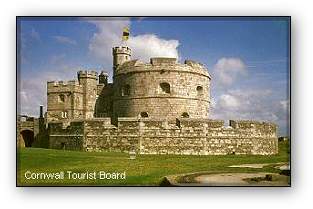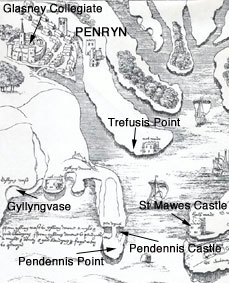Pendennis Castle
 Falmouth,
Cornwall TR11 4LP Tel. 01326 316594 Fax. 01326 319911
Falmouth,
Cornwall TR11 4LP Tel. 01326 316594 Fax. 01326 319911
Location: Pendennis headland, half mile from Falmouth town centre. 'Land Train' Service from town (summer). Castle signposted from the town.
How to get there:
Road: On Pendennis Head 1m SE of Falmouth.
Train: stops at Falmouth Docks.
Map Reference: SW 827315
 Pendennis
Castle has defended the anchorage of the Carrick Roads for over 450 years.
Today you re-visit the castle's history from Tudor times to the re-fortification
in both world wars. Along with a museum and discovery centre are displays
of coastal defence armament and access to the former secret installations.
Pendennis
Castle has defended the anchorage of the Carrick Roads for over 450 years.
Today you re-visit the castle's history from Tudor times to the re-fortification
in both world wars. Along with a museum and discovery centre are displays
of coastal defence armament and access to the former secret installations.
In the late 1530's Henry VIII was under threat of war from France and Spain because he had divorced his Catholic wife, Catherine of Aragon. As a consequence, Henry set about the fortification of the whole of England's south coast.
Between the years 1540 and 1545, the River Fal, had two forts constructed to guard its wide entrance - St Mawes on the east bank and Pendennis on the west. St Mawes had a great deal of effort put into its construction, with quality stone and decorative carvings. Pendennis, on the other hand, was a simple round tower and gate enclosed by a lower curtain wall.
 During
the reign of Elizabeth I, an extra wall was constructed - encircling the
structure, and bastions were built at Pendennis. In the year 1595, the
Spanish attacked Mounts Bay - Newlyn and Penzance. The garrisons at Pendennis
and St Mawes, were hurriedly reinforced and improved in preparation for
the coming Spanish Invasion. However the Spanish invasion never came and
the only attacks on the castles were from the English during the Civil
War.
During
the reign of Elizabeth I, an extra wall was constructed - encircling the
structure, and bastions were built at Pendennis. In the year 1595, the
Spanish attacked Mounts Bay - Newlyn and Penzance. The garrisons at Pendennis
and St Mawes, were hurriedly reinforced and improved in preparation for
the coming Spanish Invasion. However the Spanish invasion never came and
the only attacks on the castles were from the English during the Civil
War.
The historic siege of Pendennis Castle began in 1646 when Parliamentary forces attacked the fortress from both land and sea. They quickly cut the castle's lines of communication and supplies with trenches and gun positions, running from Gyllyngvase on the west across to the area that currently is occupied by the docks. Cromwell's Roundheads set up headquarters in Falmouth at Arwenack House, the burnt out home to the Killigrew family. The Garrison at Pendennis under the command of the 80 year old Sir John Arundel and assisted by Sir Henry Killigrew ( Member of Parliament), held out for six months, being reduced to eating horse and dog meat before their final surrender to the Parliamentarian force. Pendennis had been the penultimate stronghold - after Raglan Castle -in the country to hold out for the King, after earlier giving sanctuary to Queen Henrietta Maria, and the Prince of Wales (Charles II), before their escape to France.
The location of the castle high on the hill overlooking the surrounding area and town gave the defenders a great advantage, enabling them to hold out for so long against the Parliamentarian force. St Mawes, on the opposite bank was in a weaker position strategically - built half way up the hill, purely as as a seaward deterrent, the castle had no defence from a land based attack. The governor at St mawes immediately surrendered to the Parliamentarian forces. Both forts were part of Britain's coastal defence system during both World Wars.
The castle has a Discovery Centre, which allows visitors to explore the fascinating history of the castle, complete with interactive displays and activities, including an exhibit on Tudor battles. There are many medieval re-enactments staged at Pendennis. A Land Train' runs from Falmouth to the castle car park during the summer months.

 English
Heritage Sites in Cornwall:
English
Heritage Sites in Cornwall:
Chysauster Ancient Village |
Launceston Castle | Lostwitiel Castle |
St. Mawes Castle | Pendennis Castle |
Tintagel Castle



